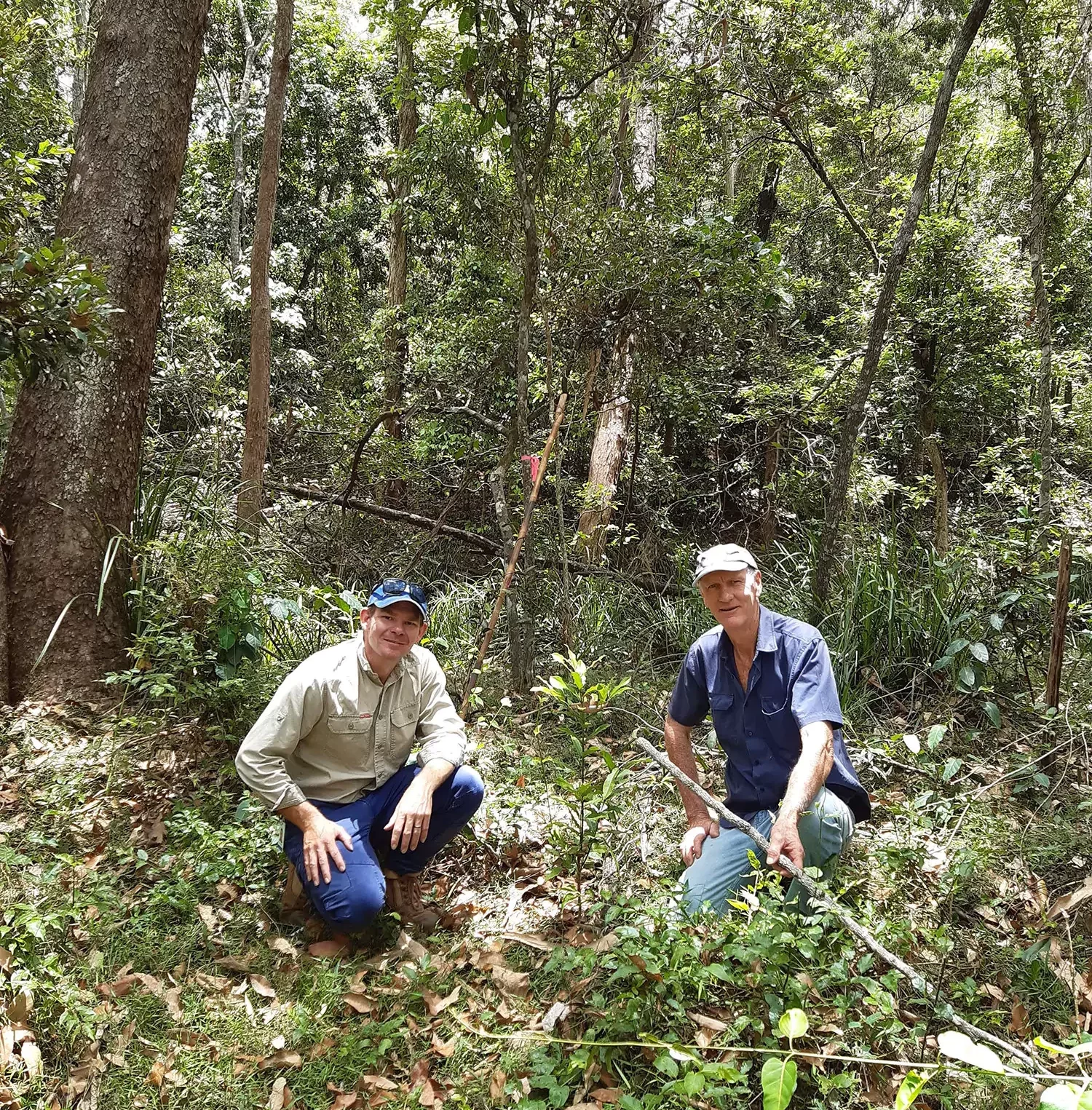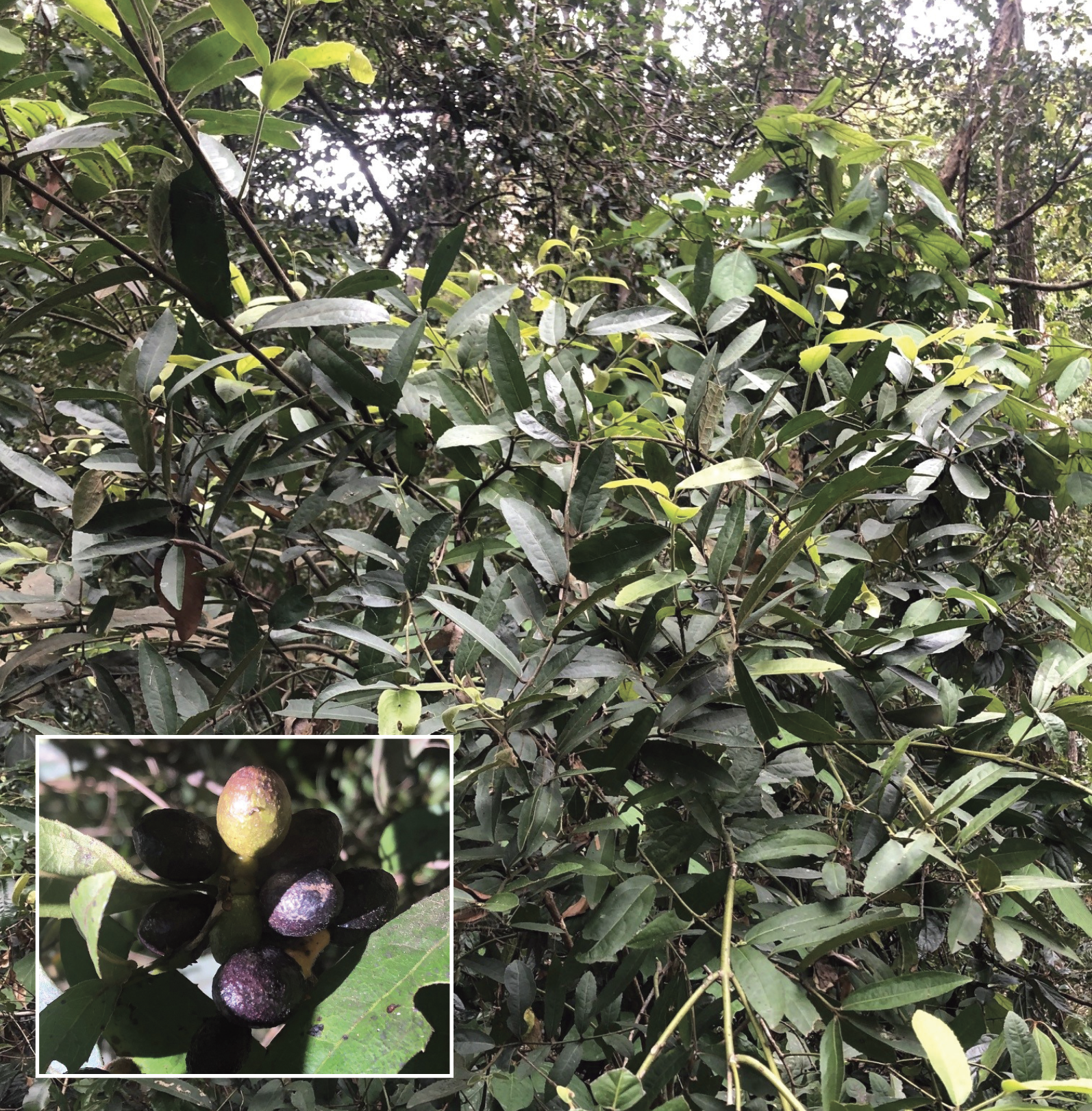One of the many reasons I love being a Land for Wildlife Officer, is the people I meet and the expertise they harbour and share. Dr Don Sands (OAM and ex-CSIRO entomologist) is one such person.
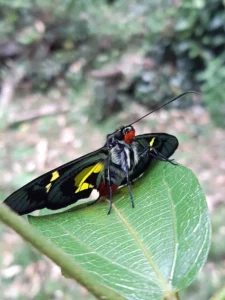
While I was working with Don to build a corridor of Richmond Birdwing Vines on Land for Wildlife properties in Brisbane, he mentioned a planting in which he assisted some 20 years ago on a property in Burbank. This property was acquired by Brisbane City Council a few years ago and we visited the site in 2019 to see how the Richmond Birdwing Vines were going. To our amazement we found curtains of Richmond Birdwing Vines stretching way into the rainforest canopy, but alas, no Richmond Birdwing butterflies.
However, what we did find was just as exciting. Don informed me that all those years ago when he planted the vines, he found a small population of a beautiful little butterfly called a Regent Skipper, one of two populations known in Brisbane, the other in Pullenvale. The Pullenvale population is now extinct, most likely due to inappropriate fire regimes. These butterflies exist in Burbank due to a significant population of their food plant Veiny Wilkiea (Wilkiea huegeliana) growing along the creek and surrounding rainforest.
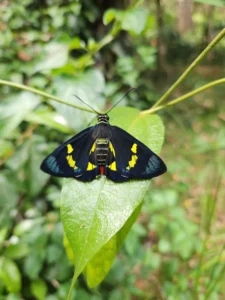
Due to the low light conditions, we didn’t see any Regent Skipper butterflies, although we did find their caterpillars. Interestingly, these caterpillars mostly shelter during the day between two leaves that they join together with silk. During low light hours they leave this shelter to feed on their host plants, usually one of the four Wilkiea species found on the east coast of Queensland. According to Don, Regent Skippers are relatively uncommon in south-east Queensland and are very rare in Brisbane. Habitat destruction and wildfire are the main threats to both Regent Skippers and their food plants.
Coincidently, I had previously seen Regent Skipper butterflies and caterpillars with Don years earlier feeding on Smooth Wilkiea (Wilkiea austroqueenslandica) overlooking Tallebudgera Creek at Burleigh Heads National Park. At that stage I didn’t realise how special these butterflies were as I was more interested in the Richmond Birdwings flying through the rainforest canopy.
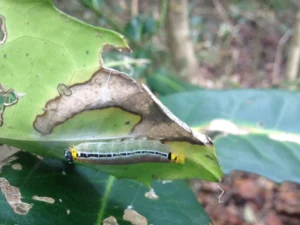
Immediately after our sighting in Burbank my memory brought me back to an article in the July 2018 LfWSEQ newsletter on Regent Skippers (available on the LfWSEQ website).For those who need a re-cap, Regent Skippers are small by butterfly standards, but large for the skipper family (Hesperiidae). It is only found on the east coast of Australia and is the only member of its genus, Euschemon. They are an ancient butterfly and considered to be the link between moths and butterflies. The male possesses a frenulum, which links the fore and hind wings together. This structure is only found in moths and was thought to be a separation of the two major Lepidoptera families (moths and butterflies) until the Regent Skipper was discovered. Although mostly black, the wings have bright yellow markings with lighter blue markings and its head and abdomen are scarlet and dramatically stand out.
Not known to venture far from its rainforest communities, their food plants in south-east Queensland are Large-leaved Wilkiea (Wilkiea macrophylla), W. huegeliana and W. austroqueenslandica. These rainforest shrubs are all dioecious, meaning male and female organs appear on separate individuals. Their fruits are ovoid, 15-20mm long that turn shiny black when ripe. They are spread by birds throughout the rainforest and are easy to propagate when the fleshy outside is removed. Wilkieas are among the most ancient of flowering plants.
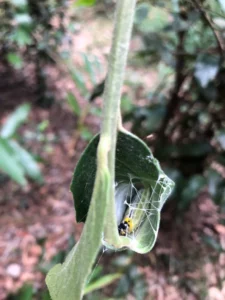
Two of the three Wilkieas occur within Brisbane, with W. macrophylla found in the western suburbs of Brookfield, Upper Brookfield and Pullenvale in undisturbed rainforest gullies and creeks. Despite extensive surveys, I have unfortunately never encountered a Regent Skipper in the western suburbs of Brisbane.
In 2019, my luck finally changed when I was planting Richmond Birdwing Vines on a Land for Wildlife property in Burbank, eastern Brisbane. This particular property was in an amazing condition and had great linkages along the same creek to the council reserve Don and I had surveyed. While planting, I stumbled across a small Wilkiea huegeliana. An extensive survey of the property found a further dozen plants and to my surprise two leaves joined together with silk and a Regent Skipper larva inside. From the corner of my eye, I also had a fleeting glimpse of a red, yellow and black butterfly that could have only been one thing. Excitedly, I told the property owner that this was probably the first Regent Skipper to be found on a Land for Wildlife property in Brisbane.
Going back to the office, my thoughts went to how we could secure and extend the population of this uncommon butterfly in Brisbane. Immediately, I wanted to plant more Wilkiea huegeliana on the site to add to the half a dozen existing plants. We secured 40 from a local nursery and with the help of the property owner put them in the ground only a month later.
I also looked at Atlas of Living Australia and iNaturalist to see if there are any other sightings of Regent Skippers in Brisbane. Other than my sighting, there were two other records in the same area. I cross-referenced them with Wilkiea huegeliana and not surprisingly there was an overlap in distribution. We ground-truthed these records and found dozens of large plants to 5m tall in a rainforest gully. Although worthy of future surveys, there was no evidence of Regent Skippers. This confirmed my suspicion that this small population of Regent Skippers in Burbank is more than likely the only existing population remaining in Brisbane.
Exploring further planting options, we worked with landholders on a further five Land for Wildlife properties at Burbank with ideal habitat for Wilkieas and the butterfly. Two of these properties had small numbers of Wilkiea huegeliana to which we added. One property was adjacent to our very first planting and it contained about half a dozen W. huegeliana. While adding another 20 to the existing plants, I again noticed a butterfly with yellow and black wings and a splash of red flittering quickly through the forest. Knowing exactly what it was, I followed it and to my luck it settled on the leaves of a Cryptocarya microneura. There it sat, showing off its bright yellow and red colours in the sun for a few minutes while we all admired it and took photos.
Since these discoveries, both the Regent Skipper and Wilkiea huegeliana have been placed on the list of Citywide Significant Species by Brisbane City Council. We also managed to collect hundreds of fruits of W. huegeliana, which we gave to a nursery for propagation. We also planted another 100 plants on the remaining four identified Land for Wildlife properties. Although losing a few in the February 2022 floods, most plants survived and are growing quite well. Despite their slow growth, some are now almost a metre high and aren’t far away from becoming food for a Regent Skipper in the next year or two.
Over the next couple of months, I aim to survey all the properties on which we have planted Wilkieas and will be seeking out further properties to extend the corridor. With assistance of Land for Wildlife members, the aim is to secure and extend the population of Regent Skippers and their food plants throughout Burbank. There is also an opportunity to create corridors of Wilkiea huegeliana by connecting existing populations of this plant and therefore enabling Regent Skippers to extend their range.
Article by Cody Hochen
Land for Wildlife Officer
Brisbane City Council
References & Further Reading
Braby MF (2016) The Complete Field Guide to Butterflies of Australia. CSIRO Publishing.
Moss JT (2008) Butterfly host plants of south-east Queensland and northern New South Wales. Butterfly and Other Invertebrates Club.
Leiper G, Glazebrook J & Cox D (2022) Mangroves to Mountains. Third Edition. Logan River Branch, Native Plants Qld.
https://en.wikipedia.org/wiki/Euschemon
https://inaturalist.ala.org.au/taxa/342449
http://lepidoptera.butterflyhouse.com.au
www.lfwseq.org.au/newsletters
www.youtube.com/watch?v=eog6TWeZTto

